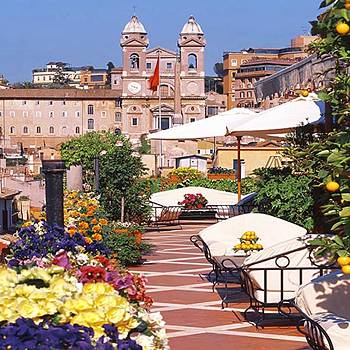Like Father, Like Son – or Daughter – but, with a difference! Young, blue-eyed auburn-hairedand fair-skinned beauty from Egypt, with a doctorate in the History of Architecture at a very young age, decides to promote Egyptian architect and icon in architecture – our world famous Master: Architect Hassan Fathy. How will she do this impossible mission single-handed? What are her methods? Why spend so much time, expense and effort?
On first impression, one sees a rather petite, very fair-complexioned feminine lady, in the latest Parisian fashion, with her teenage daughter; the typical type men dream about in their fantasies! Yet, Alice, looking like a Babushka Russian doll, is innocent in the latest fashion of casual jeans and jacket, with clumpy (designer) sports shoes, and braided blonde hair.
To start at the beginning, Dr. Leila El-Wakil is Egyptian, and was born in Cairo to a half French-Swiss beautiful mother, Mrs. Jamila El-Ghayaty and very handsome father, Dr. Mokhtar El-Wakil, who was a famous writer and poet in Egypt. She apparently inherited her navy-blue eyes from him and her chestnut-coloured hair from her mother, as well as her artistic talents from both. When Leila was three and a half years old, the family moved to Switzerland because her father had a job assignment there, and eventually they remained in Geneva, Switzerland, where she started and finished her education. In 1985, at the age of 24, she achieved her “Doctorat en ES Lettres (a doctorate; Ph.D.) - in “The History of Art”. Hassan Fathy (“The Architect for the Poor”) - was born in Alexandria on 23 March 1900 and died in Cairo in 1989. He is Egypt's best known architect since Imhotep. In the course of a long career with a crescendo of acclaim sustaining his later decades, the cosmopolitan trilingual professor-engineer-architect, amateur musician, dramatist, and inventor, designed nearly 160 separate projects, from modest country retreats to fully planned communities with police, fire, and medical services, with markets, schools and theatres, with places for worship and others for recreation, including many, like laundry facilities, ovens, and wells that planners less attuned to sociability might call workstations. Hassan Fathy graduated from the Faculty of Engineering, Architectural Section, University of King Fouad in 1926 (now University of Cairo) Cairo. Although the importance of Fathy's contribution to world architecture became clear only as the twentieth century waned, his contribution to Egypt was obvious decades before, at least to outside observers. As early as halfway through his three building seasons at New Gourna (a town for the resettlement of tomb robbers, designed for beauty and built with mud) the project was being admired abroad. In March 1947 it was applauded in a popular British weekly, half a year later in a British professional journal, and praise from Spanish professionals followed the next year. A year of silence (1949, when Fathy published a literary fable) was followed by attention in one French and two Dutch periodicals, one of which made it the lead story. Fathy's next major engagement, designing and supervising school construction for Egypt's Ministry of Education, further extended his leave from the College of Fine Arts, where he had begun teaching in 1930. In 1953 he returned, heading the architecture section the next year. In 1957, frustrated with bureaucracy and convinced that buildings would speak louder than words, he moved to Athens to collaborate with international planners evolving the principles of acoustical design under the direction of Constantine Doxiadis. He served as the advocate of traditional natural-energy solutions in major community projects for Iraq and Pakistan and undertook, under related auspices, extended travel and research for a "Cities of the Future" program in Africa. Briefly married to Aziza Hassanein, he left no direct descendants, but the children of his five brothers and sisters, aware of the obligation to preserve the heritage of an uncle of such imposing stature, have taken pains to ensure that the materials transmitting his ideals and his art will remain available in Egypt, for the future benefit of the country for which he cared so deeply. Fathy devoted himself to housing the poor in developing nations and deserves study by anyone involved in rural improvement. Fathy worked to create an indigenous environment at a minimal cost, and in so doing to improve the economy and the standard of living in rural areas. Fathy utilized ancient design methods and materials. He integrated a knowledge of the rural Egyptian economic situation with a wide knowledge of ancient architectural and town design techniques.
He trained local inhabitants to make their own materials and build their own buildings. Climatic conditions, public health considerations, and ancient craft skills also affected his design decisions. Based on the structural massing of ancient buildings, Fathy incorporated dense brick walls and traditional courtyard forms to provide passive cooling.
His Career:
1926-1930 Worked at the Department of Municipal Affairs, Cairo.
1930-1946 Taught at the Faculty of Fine Arts, Cairo.
1937 Designed and exhibited first mud brick projects - country houses for Lower Egypt.
1941 Constructed first mud brick structures incorporating the inclined vault - experimental housing in Baltim, Egypt, commissioned by the Royal Society of Agriculture.
1946-1953 Delegated to the Antiquities Department to design and supervise the project of New Gourna Village at Luxor, to displace the inhabitants of the Old Gourna from the Antiquities Zone.
1949-1952 Appointed Director of the School Building Department, Ministry of Education.
1950 Delegated Consultant to the United Nations Refugee World Assistance.
1953-1957 Returned to teaching at the Faculty of Fine Arts, Cairo. Head of the Architectural Section in 1954.
1957-1962 Joined Doxiades Associates in Athens as consultant. Lecturer on Climate and Architecture at the Athens Technical Institute. Member of the Research Project for the City of the Future.
1963-1965 Director of Pilot Projects for Housing, Ministry of Scientific Research, Cairo. Designed High Institute of Social Anthropology and Folk Art for the Ministry of Culture, Cairo. Worked as Consultant to the Minister of Tourism, Cairo. Delegated by the United Nations Organization for Rural Development Project in Saudi Arabia.
1966 Lectured on philosophy and aesthetics in Town Planning and Architecture at El-Azhar University.
1975-1977 Lectured on rural housing at the Faculty of Agriculture, Cairo University. Honorary Fellow, American Institute of Architecture, 1976.
1976-1980 Member, Steering Committee, Agha Khan Award for Architecture.
1977 Founder and Director, the International Institute for Appropriate Technology.
Member of the High Council of Arts and Letters, Egypt. Honorary Fellow, American Research Centre, Cairo.
His Awards:
1959 Encouragement Prize for Fine Arts and Gold Medal.
1967 National Prize for Fine Arts and Republic Decoration.
1980 Chairman's Award, the Agha Khan Award for Architecture.
1984 Union Internationale des Architectes, Gold Medal.
In Architect Hassan Fathy’s own words:
Quote: “Since antiquity, man has reacted to his environment, using his faculties to develop techniques and technologies, whether to bake bread or make brick, in such internal psychological balance with nature that humanity historically lived attuned to the environment. Man's creations were natural when built of the materials offered by the landscape.
Learning to manipulate clay, stone, marble, and wood, man penetrated their properties, and his techniques gave expression to his aspirations toward the divine. In architecture, environmental harmony was known to the Chinese, the Indians, the Greeks, and others. It produced the temples of Karnak, the great mosques of Islam, and the cathedral of Chartres in France.
With the advent of the industrial revolution, the inherited techniques and perfected knowledge of creating, using handmade tools, were lost and are now forgotten. Energy-intensive mechanized tools have diminished man's personal, cellular contribution to the fabrication of objects, the building of structures, and the growing of food. The lesser the challenge for man to imprint his genius, the less artistic is the product.
The resulting economic and political disturbances are visible today. Production of beauty, once the prerogative of millions, is replaced by industrialization, even of bread, under the control of a minority of owners. The negative consequences of the industrial revolution have disturbed the natural organization of the divine concept for humanity.
Sixty years of experience have shown me that industrialization and mechanization of the building trade have caused vast changes in building methods with varying applications in different parts of the world. Constant upheaval results when industrially developed societies weaken the craft-developed cultures through increased communications. As they interact, mutations create societal and ecological imbalance and economic inequities which are documented to be increasing in type and number.
Profoundly affected is the mass of the population, which is pressured to consume industrially produced goods. The result is cultural, psychological, moral, and material havoc.
Yet it is this population that has an intimate knowledge of how to live in harmony with the local environment. Thousands of years of accumulated expertise has led to the development of economic building methods using locally available materials, climatization using energy derived from the local natural environment, and an arrangement of living and working spaces in consonance with their social requirements. This has been accomplished within the context of an architecture that has reached a very high degree of artistic expression.
At all costs, I have always wanted to avoid the attitude too often adopted by professional architects and planners: that the community has nothing worth the professionals' consideration, that all its problems can be solved by the importation of the sophisticated urban approach to building. If possible, I want to bridge the gulf that separates folk architecture from architect's architecture. I always wanted to provide some solid and visible link between these two architectures in the shape of features, common to both, in which the people could find a familiar point of reference from which to enlarge their understanding of the new, and which the architect could use to test the truth of his work in relation to the people and the place.
An architect is in a unique position to revive people's faith in their own culture. If, as an authoritative critic, he shows what is admirable in local forms, and even goes so far as to use them himself, then the people at once begin to look on their own products with pride. What was formerly ignored or even despised becomes suddenly something to be proud of. It is important that this pride involves products and techniques of which the local people have full knowledge and mastery. Thus the village craftsman is stimulated to use and develop the traditional local forms, simply because he sees them respected by a professional architect, while the ordinary person, the client, is once more in a position to understand and appreciate the craftsman's work.
In spite of this, we are witnessing a change that is now forcing a complete rupture with the past; every concept and every value has been reversed. For house design in the Middle East, the introverted plan wherein family life looked into the courtyard was changed to a plan with family life looking out upon the street. The cool, clean air, the serenity and reverence of the courtyard were shed, and the street was embraced with its heat, dust, and noise. Also, the qa'a [a central, high-ceilinged upper-story room for receiving guests, constructed so as to provide natural light and ensure ventilation] was supplanted by the ordinary salon, and all such delights as the fountain, the salsabil [a fountain or a basin of still water designed to increase air humidity] and the malk-haf [wind catch] were discarded in the name of progress and modernity.
It may seem that, from the functional point of view, mechanical air-conditioning was made possible by modern technology; but we must recognize that such technologies also have a cultural role. In fact, this role may be even more important than the function it serves, considering the special place occupied by the decorative arts in many cultures.
Thus when the modern architect replaced these decorative elements with air-conditioning equipment, he created a large vacuum in his culture. He has become like a football player playing football with a cannon. If the purpose of the game is scoring goals, then assuredly he can score a goal with every shot. But the game itself will disappear, and so will any diversion for the spectators, except perhaps in the killing of the goalkeeper.
Every advance in technology has been directed toward man's mastery of his environment. Until very recently, however, man always maintained a certain balance between his bodily and spiritual being and the external world. Disruption of this balance may have a detrimental effect on man, genetically, physiologically, or psychologically. And however fast technology advances, however radically the economy changes, all change must be related to the rate of change of man himself. The abstractions of the technologist and the economist must be continually pulled down to Earth by the gravitational force of human nature.
Unhappily, the modern architect of the Third World, suddenly released from this gravity, and unable to resist temptation, accepts every facility offered to him by modern technology, with no thought of its effect on the complex web of his culture. Unaware that civilization is measured by what one contributes to culture, not by what one takes from others, he continues to draw upon the works of Western architects in Europe and North America, without assessing the value of his own heritage.
In order to assess the value of our heritage in architecture and to judge the changes that it has undergone, there is a need to analyze scientifically the various concepts of design, and to clarify the meaning of many terms that the modern architect uses freely in his professional jargon, such as "contemporaneity". The role architecture and town planning play in the progress of civilization and culture must be grasped. While change is a condition of life, it is not ethically neutral. Change that is not for the better is change for the worse, and we must continually judge its direction. Architecture concerns not technology alone but man and technology, and planning concerns man, society, and technology.
In architectural criticism, the concepts of past, present, and future are used capriciously, and the present is extended to mean the whole modern epoch. To avoid being arbitrary, we must establish some standards of reference that involve the concept of contemporaneity.
The word "contemporary" is defined as meaning "existing, living, and occurring at the same time as." The word implies a comparison between at least two things, and it conveys no hint of approval or disapproval. But as used by many architects, the word does carry a value judgment. It means something like "relevant to its time" and hence to be approved, while "anachronistic" means "irrelevant to its time" and is a term of disapproval. This raises the two questions of what we mean by time and what we mean by relevance, and to what.
Now, if we are to reconcile chronological time with the artist's definition of contemporaneity, we may say that to be relevant to its time, to be contemporary, a work of architecture must be part of the bustle and turmoil, the ebb and flow of everyday life; it must relate harmoniously to the rhythm of the universe, and it must be consonant with man's current stage of knowledge in the human and the mechanical sciences, and in their inseparable relationship within planning and architectural design.
To judge the criterion of contemporaneity, we must sense the forces that are working for change, and must not passively follow them but rather control and direct them where we think they should aim. Physical and aerodynamic analysis has shown that many of the concepts embodied in the design of houses of the past remain as valid today as they were yesterday and that, judged by the same standards, much of what is called modern is in fact anachronistic. We must determine what is basic and constant and thus worth keeping, and what is ephemeral and transient and can be discarded.
Looking to the future, we see that the situation at any given time largely determines the coming stage in development and change. Thus there would be no problem were the present situation of architecture normal, that is to say, truly contemporary. The future would then take care of itself. But unfortunately that is not the case, and it is the responsibility of the modern architect to find a remedy. He must renew architecture from the moment when it was abandoned; and he must try to bridge the existing gap in its development by analyzing the elements of change, applying modern techniques to modify the valid methods established by our ancestors, and then developing new solutions that satisfy modern needs.” End of Quote
Hassan Fathy developed his own ideas, inculcating traditional Arab styles like the malk-haf (wind catcher), the shukshaykha (lantern dome) and the mashrabeya (wooden lattice screens). He designed complete communities including utilities and services, country retreats, and special projects and homes. Hassan Fathy had already worked for decades in his beloved Egypt before he designed and built for the homeless community of Gourna, Upper Egypt, which attracted international acclaim.
The Department of Antiquities commissioned Hassan Fathy to meet the challenge of providing a home for a poor community of 7,000 people. His solution differed drastically, not requiring the machinations of the established building industry of concrete and steel. For New Gourna he utilized natural resources using mud-brick, a signature of adobe architecture, and features of Egyptian architecture such as enclosed courtyards and domed vaulted roofing.
He worked with the local people to develop the new village, training them to make the materials to construct their own buildings with. In this way, he was able to provide an environment specific to the inhabitants’ needs and revive decorative techniques that were quickly disappearing with the expansion of the Global Village.
While many may suffer from the amplified ultraviolet rays that hit our concrete structures and rebound onto us in hot weather conditions, Hassan Fathy’s contribution reminds us of the need for the climatically conducive, cost-effective, cooling promises of certain traditions that would
His work took him too many countries, especially since the publication of the 1973 English edition of the book Architecture for the Poor. In Athens he joined international planners, looked at the concept of cities for the future in Africa, and focused on natural energy solutions in major community projects for Iraq and Pakistan. He participated in the United Nations Habitat conference in 1976, served on the steering committee for the Award for Architecture and founded the Institute for Appropriate Technology.
For this level of dedication, Hassan Fathy received the Right Livelihood Award for saving and adapting traditional knowledge for adaptation to the needs of the poor. Known as the “Alternative Noble Prize,” it was established in 1980, the same year that Hassan Fathy was given an award that “embodies the principle that each person should follow an honest occupation which fully respects other people and the natural world. It means being responsible for the consequences of our actions, and taking only a fair share of the earth’s resources."
Ambitious goals to be applauded, the principles of Right Livelihood are ones that are intrinsic to Islam, principles that, with commitment, create a pathway towards instilling balance within the societies in which we live.
Hassan Fathy died in 1989, but his legacy lives on in his disciples with ideas of their own. Mohamed El-Sharkawy and fellow young architects spent 1969–1972 under Fathy’s tutorship, researching the region for the viability of the Luxor Cultural Centre in Upper Egypt. “We spent five months studying the region, going from village to village to understand what would be appropriate for the locals and tourists in order to conceptualize and then draw up the project.”
Now his focus has been the extended family which, despite its importance in Egyptian society, has an aspect that is rarely considered in building design. The materials used in modern building obstruct the flow of air, making air-conditioning essential. Sharkawy does not use Nubian vaults and domes, which would be difficult to employ in highly populated Cairo, but he worked on a design in the less populated 6th October City on the outskirts of Cairo. There, he re-introduced the internal courtyard on the first two floors. The stairwell serves as a ventilation shaft with a malk-haf at the top.
Soheir Farid and Ramy El-Dehan met under the tutelage of Hassan Fathy. More faithful to the principles of Hassan Fathy, their partnership in business as well as marriage has attracted much admiration in the tourist industry. They began the construction of Quseir Mövenpick resort in 1987 and completed it in 1994. Their aim is not to challenge, impose on, or obstruct the local topography, nor to upset the social fabric of the region. Built on a peninsula, “We did not dig or fill the site, but we began by making a topographical map and study of the site. Every room is at a different level, depending on the curvature of the land,” said Soheir Farid. The domes and vaults add a sense of mystery to the place, providing a natural means of ventilation.
American architect Michael Graves was impressed by Farid and El-Dehan’s self-assured and beautifully accomplished application of Fathy’s techniques in the vaults and domes of the staff dormitories in El-Gourna, southeast of Cairo. He was so impressed that he managed to convince Egyptian construction magnate Samih Sariwis to forget about concrete and steel for the five-star Miramar Hotel. Commissioned by Sawiris for this purpose, Graves built the Miramar entirely of brick, covered with concrete and gypsum and accessorized with domes and vaults.
Ramy El-Dehan felt that Fathy would have been pleased because he also built for the rich, in the knowledge that the poor like to emulate the rich, and in this manner the taste for vernacular architecture would find its way back to the source. How fortunate it is that there are those who choose not to live any other way other than this because they feel claustrophobic within concrete walls. In this way, we can be reminded.
In his book An Architect for the People, American architect James Steele wrote of Fathy, “rather than believing that people could be behaviourally conditioned by architectural space, Fathy felt that human beings, nature, and architecture should reflect the personal habits and traditions of a community rather than reforming or eradicating them. While he was certainly not opposed to innovation, he felt that technology should be subservient to social values, and appropriate to popular needs.”
If we think about it long enough, we might find that it is not us controlling our own personal spaces at all, but we are accepting those spaces with all their demands. If we were to adapt them according to our psychological, spiritual, physical, and economic needs, we might begin to experience a little of what Hassan Fathy set out to achieve.
I asked Dr. Leila El-Wakil, “What inspired you to study Literature?” She is very soft-spoken, and in her feminine little voice, her answer surprised me, denoting a hidden strong character and personality underneath the femininity, striving for originality and uniqueness, for she replied, “I didn’t want to study Literature, like my parents! Actually, I wanted to build, and construct things! But, when I took my subject for the doctorate, at first I thought I would be studying mainly artistic things, as in Fine Arts, but did not realize it would include rules, materials and mathematics!”
In any case, her studies included all types of art, but then Leila chose to specialize in Architecture, where she achieved her doctorate. She then soon became a professor of architecture to students, teaching “the history of architecture”, and half of the students were much older than she was then! She started as an Aide to Assistant Professor, for six years, and then Assistant Professor, which is a notch higher, and gradually, yet speedily, became a prominent Professor in the History of Architecture at the University of Geneva, in Switzerland.
Actually, she is now “Professor of Assignments and Research”, where this type of academic branch is associated to the university, rather than being a direct participant in the daily criteria. In French, her job title is: “Maître d’Enseignement de Recherche”, amongst other titles.
While working as Maitre d’Enseignement de Recherche, Dr. Leila El-Wakil won a sort of scholarship by the “Fondation National de la Recherche Scientific”, where she was assigned another post, simultaneously, for three years.
On top of that, she soon gradually became “Charger de Cours”, implying that she is the Professor in charge of the courses of that specific field. She soon became, and is up to the present date, the official “Maître d’Enseignement de Recherche de l’Universite”, which is directly affiliated to the University of Geneva. Her recent mission to Egypt was of her own initiative, and at her own expense. Some Egyptian association or Egyptian reimburse the expenses she incurred for promoting Egyptian Architecture, and endorse this project.
“What made you decide to return to Egypt, on your own, to promote the world renowned Egyptian Architecture, and ‘the Master’, Hassan Fathy? Was it your own initiative, or did the University of Geneva send you on this mission?”
Dr. El-Wakil answered, “I spent twenty years of my life devoted to European architecture in all its eras, and teaching it to generations of students. Now I want to dedicate and devote the next fifteen years of my life to Egyptian architecture. I decided it was about time to promote the unique and famous Architect Hassan Fathy. Heis an icon of supreme simplicity; a genius in art in his theories and constructions. His work is a study for all future generations as well, as it complies with the ever-endangered environment.”
I asked her then, “Are you getting paid for this?” Her reply was, “Maybe. I hope so, because I intend to do an exhibition in Europe, about Hassan Fathy and his work.”
“What type of exhibition, and approximately when would that occur?” I enquired. Furthermore, Architect Hassan Fathy left a lot of drawings, sketches, writings and diagrams, which are collected now in the Rare Books Library of the AUC (American University of Cairo). After collecting a big portion of his work, she will write another book about him and his autobiography.
“Well, first I will go to the AUC’s Rare Books Library where they keep all his archives, and then collect the data, sketches, and literary material by him, and about him. Some are in English, and some are in Arabic, which will need to be translated into French as well. This will take me several months to complete, and so I must return to Egypt for at least two consecutive years, as we are not allowed to take out any material from the Library, and so I must copy and type all the documents on my laptop. I also want to visit Upper Egypt, where I heard that he has designed some Nubian villages, as well as other rustic areas. Apparently there are some old buildings in Cairo also which were designed or constructed by him and still intact, and I heard lately that the building Number 44 in Falaky Street, was also designed by Hassan Fathy. ”
In October 2007, Dr. Leila El-Wakil ... (whom I am proud to say is my cousin!) ... returned to Egypt to continue and complete her research for a new book about The Master – Hassan Fathy. She was also invited to attended the 3-day conference in Alexandria, where the Bibliotheca Alexandrina held a seminar and exhibition about Hassan Fathy and his work, in which a brochure with his portrait was distributed, with the quotation Hassan Fathy; The Man and His Legacy. Dr. El-Wakil also participated in the actual seminar and gave a half-hour speech (The Unknown Hassan Fathy) from 10:30 to 11:00 a.m.
Her daughter, a beauty now and turning 19 in December, joined her mother for two weeks only. Dr. Leila preceded her a week in advance, and left a week later…on November 4th 2007. I was happy to meet her again, although she was barely able to make time for family visits, and I wished her the best of luck for the book she intends to write about Hassan Fathy.
As soon as the book is published and in the market, I will be one of the first to purchase that book, and know that behind the biography, was a very hard-working, brilliant and dedicated researcher and author.
H.N.
































































































































